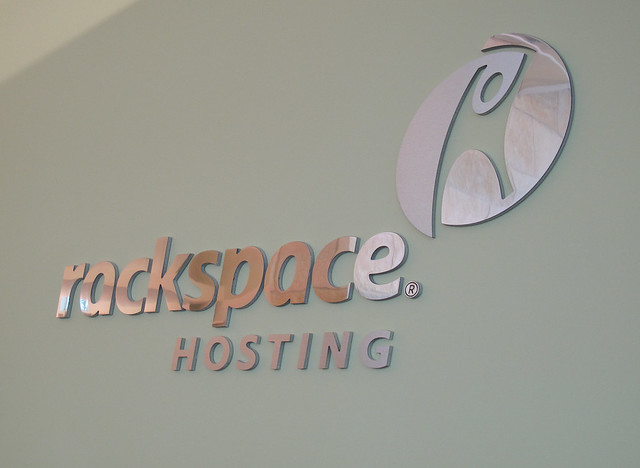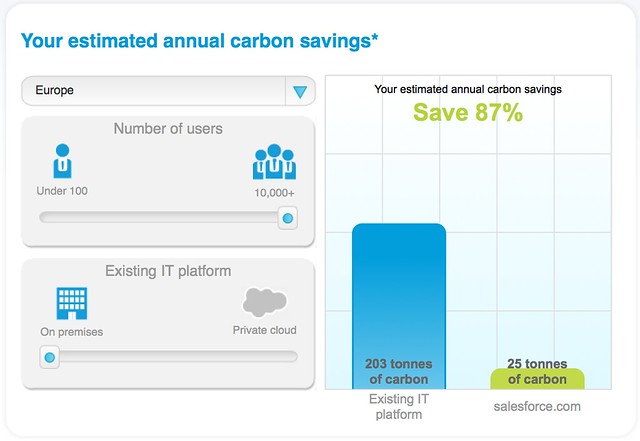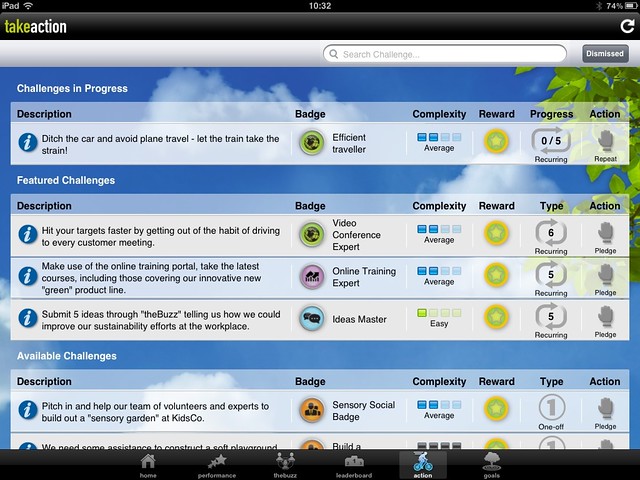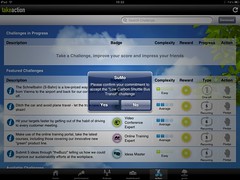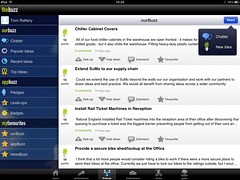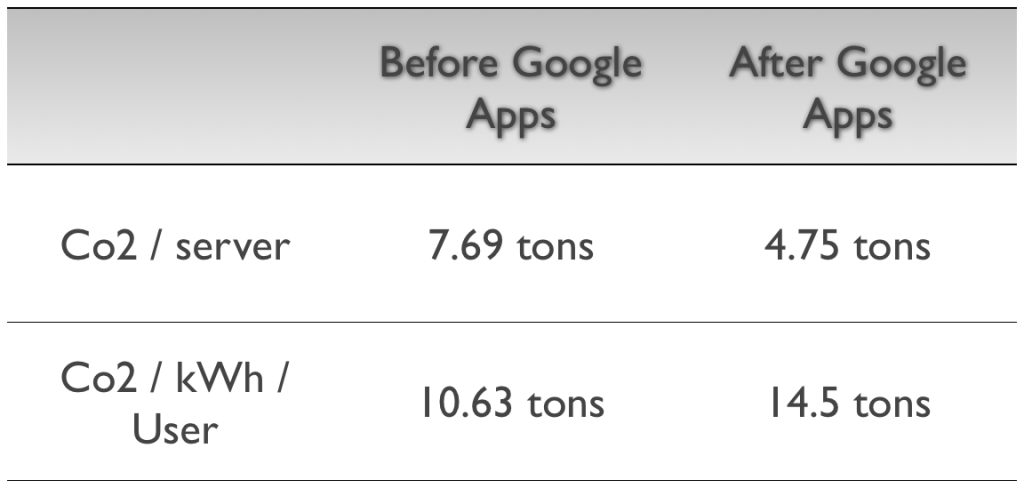This is a video of me giving the opening keynote at the Cloudstack Collaboration conference in Las Vegas last December. The title of my talk was Can we hack open source cloud platforms to help reduce emissions and the slides are available on SlideShare here if you want to download them, or follow along.
Be warned that I do drop the occasional f-bomb in the video, so you might want to listen to this with headphones on if there are people nearby with sensitive ears 😉
And I have a transcription of the talk below:
Good morning everyone! I’m absolutely astounded of the turn out at this time on a Saturday morning. I said to Joe yesterday evening, I think it was, that I reckoned it would be just me and the AV guy here this morning but now you’ve turned up. That’s a fantastic, phenomenal. Thank you so much. I hope we make it worth your while. My talk, Joe mentioned I’m from RedMonk. RedMonk is an analyst firm. I work on the green side of a house, so I’m all about energy and sustainability. I’m talking about using open source cloud platforms to measure and report energy and emissions from cloud computing.
A couple of quick words about myself first. As I said, I lead analyst energy and sustainability with RedMonk. You can see there, my blog is on greenmonk.net. My Twitter account is there. My email address is there. My phone number is there. Please don’t call me now. I’m using the phone as my slide forwarder. SlideShare, I’ll have this talk up on SlideShare shortly.
Also, a couple of companies I’ve worked with. I worked to the company called “Zenith Solutions” back in the mid-’90s. It’s a company that I set up in Ireland. As we called it at the time, it was a web applications company. Web applications at that time morphed into SaaS, “Software as a Service.” Back in the mid to late 90s, I was setting up these Software as a Service Company, so I knew a little bit about cloud. Then Chip Electronics was an ERP company, but it was a Software as a Service delivered ERP. That was around 2002. CIX, the other company that’s there.
CIX is a data center company that I founded in 2006 in Ireland. I kind of know a little bit about cloud both from the software and from the hardware side. I’ve setup a data center and I’ve also setup software companies dealing with cloud stuff. Like I say, a little bit of the background in it. I know what I’m talking about, not that much, but I’ll bluff it.
This is a report. It’s a graph from a report that came out just a couple of weeks ago. It’s from WSP Environmental and the NRDC. Basically, what they’re saying in this report, it’s a long report, the link is at the bottom there. As I say, this talk will be on SlideShare, so you can link on the link in SlideShare and get straight to the report. What the report is saying basically is that cloud computing is green. There have been a couple of reports like that which have said that. Most of them have been tainted before now. There was one that Microsoft helped put out, obviously Microsoft have got a foot in the game so you kind of wonder about that one. There was another one that was put out by the Carbon Disclosure Project, but it was paid for by AT&T. That was highly suspect. This one’s actually quite good. They’ve done quite a bit of work on it. You actually have to take it seriously unlike the previous two and it does seem to suggest that cloud computing is green, and that’s good.
Previous ones, as I say were suspect. The issue with this that I have and it’s a small issue, but this issue or this report is a really good report but it’s speculative. It says cloud computing should be green. Probably, is green. Maybe green, but they’re not working on any hard data and that’s where we’ve got a serious problem with cloud computing.
Taking a step sideways for a second, this is a guy called Garret Fitzgerald. Garret Fitzgerald was a politician in Ireland in the ’80s and ’90s. He died last year. A very unusual politician because he was one of the very few politicians who actually have integrity, very well-know for his integrity. He was also not just known for his integrity, but he was an academic. He came from an academic background. He worked in Trinity College Dublin as a statistician, so he was a data guy.
Now, in the mid-’40s, the Aeroflot, Russian Airline Company, it was at ’47 I think or ’49, for the first time, published their flight schedule. They’d never done this before. They published their entire flight schedule, their global flight schedule. Garret Fitzgerald looked at this, analyzed it and figured out he could know by going through this in detail, he could figure out the exact size of the Aeroflot fleet down to the number and types of planes they had in their fleet, and this was a state secret.
This was nothing that had ever been published before, but by analyzing their schedules, he worked it out and he published it, and as a result, the KGB had a file on him because they thought he was a spy.
Two things about this slide, first is you do a creative common search on Flickr for KGB, and this is one of the images you’ll find. It’s got a KGB logo and his got a cat, so you got two memes right there. A, the internet is fucking awesome and B, well the main thing to take away from this is that there is no such thing as security by obscurity. Hiding your data will not work. Somebody will figure the damn thing out. That’s where we’ve got a big issue with cloud computing because there is absolutely no transparency in cloud computing.
This is a blog post that I’ve put up. If you follow greenmonk, which is where I blog at greenmonk.net, you’ll find there’s a ton of blog posts on this very topic, the lack of transparency in cloud computing. I have done blog posts about it. I’ve given webinars about it. I’ve hassled people about in the space. The SalesForces, the Rackspaces, I’ve hassled them all.
Recently, the New York Times picked up the story. I’m not going to say it has anything to do with me, they actually run a really good story. Again, the link is at the bottom there. One of the things that they have mentioned in that story — please do go and click on that link and read that article. It’s a really good article.
One of the things they have mentioned in that article is a McKinsey study. In that McKinsey study, they say that globally for data centers, somewhere between six percent and 12%, depending on the data center, somewhere between six percent and 12% of the power going into the servers in the data centers is used for computing. The other 88% is used for elasticity. It’s used to keep them going in case there’s a burst of activity, so 88%, if we take a conservative look, 88% of the power going into those servers is the E in Elastic Cloud, horrific waste.
Do you think that people’s often mistake in this area, is people often equate or conflate energy with emissions, and that’s a mistake. They are not the same thing, not at all. The reason they are not is because if you take the example of — for example, the Facebook Data Center in Prineville, Oregon, a fabulous data center. They’ve opened sourced it, the whole open compute project. They’ve opened sourced the entire building on this data center.
The data center, if you know anything about data center statistics, there’s a metric for data centers called the PUE. The PUE is the Power Usage Efficiency. The closer you are to one, the more efficient you are. Facebook’s data center comes in around 1.07 or 1.08, depending on time of the year on usage and stuff like that, but it’s in and around 1.08. It’s almost unheard of efficiency, 1.5 is kind of average, 2.0 is older data centers, and 3.0 is dirty. This is 1.07 or 1.08.
Unfortunately, although it’s extremely efficient — this is Facebook’s numbers here, 1.08 plus their computing power has declined by 38%, but the problem with that is, this data center is powered by company called PacifiCorp. PacifiCorp are the local utility in Oregon, in Prineville where this is based.
PacifiCorp mines 9.6 million tons of coal every year. It doesn’t matter how efficient your data center is. If you’re mining 9.6 million tons of coal to run your Facebook data center, it’s not green. I don’t care how efficient it is. It’s not a green.
It’s not just Facebook, it’s not just Prineville, Dublin, in Ireland, I’m Irish — guilty. Dublin has become a center for cloud computing as well. All of the big companies are there. Microsoft is there, they got their big Live servers there, Google are there, Amazon are there, they’ve all got data centers there. Ireland, unfortunately, gets 84% of its electricity from fossil fuels. Again that’s not very green. It’s not just Ireland, the U.K. is another big center for cloud computing in London, and again, over 90% of the electricity in the U.K. comes from fossil fuels. This is really, really bad stuff.
Now, if you look at this chart, this is why I say that the PUE which is in the middle column here, isn’t a whole lot important because as I said, if you look at the bottom row there, it’s got a PUE of three I said that was really dirty. Top row, PUE of 1.5 is at the average, middle row PUE of 1.2 kind of in the middle, but if you look at the power source coming into these putitive data centers, so your typical one, the top line, typical one has a supply carbon intensity of half a kilo per kilowatt hour, that’s pretty standard. If that has a data center PUE of 1.5, then you’re getting simple math, 0.75 a kilo per kilowatt hour. If you have a good PUE of 1.2, but with coal fired power coming at 0.8 of a kilo per kilowatt hour, you’re now looking at IT carbon intensity of 0.96.
Look at the bottom line, a PUE of three, one of the dirtiest data centers you can get, but it’s powered almost all by renewables, it’s not all because it’s got a 0.2 kilograms and a PUE of three, it still comes in at an IT carbon intensity of 0.6, which is far better than the 1.2 PUE or the 1.5 on typical. The take home message from this slide is that it’s the source of the electricity is what determines the carbon footprint of your cloud, not the efficiency of your data center.
Now, if we look at some of the cloud providers that are out there today and if I left anyone out, apologies, I just stuck these logos up based on the availability of the logos. It’s not an any kind of research or anything but that.
If we look at the cloud providers that are out there, these ones are semi-clean. If we look, for instance, at Rackspace, they have a data center in the U.K. which they claim as 100% powered by renewables. Now, they haven’t given us a whole load of data, but let’s just take the word on it. If you go with Rackspace and you go with their U.K. data center it’s supposedly 100% green, we’ll see. Google, Google have done a really good job on investing in renewables. They spent almost a billion dollars on buying into Windfarms, power purchase agreements with big Windfarms the whole thing. They’ve gone out on a serious limb, in terms of renewables. I’m pretty positive about them. They’re still doing a lot of the old buying carbon credits and stuff like that, but they got old data centers that they need to top up with carbon credits.
Green Cloud is an interesting one. Green Cloud are company that bill themselves as an AWS replacements, dropping AWS replacement and why they are cool is because — pun intended.
They’re cool because they’re based in Iceland. The electricity grid on Iceland is 100% renewable, its 30% geothermal, 70% hydro. The entire grid is a 100% renewable energy and it’s baseload energy and what’s even more interesting about it, as a grid is, there are 300,000 people living in Iceland, that’s it — 320,000. They’ve realized that they got this energy infrastructure and way more energy than they can every use, so they decided to invite people who need lots of energy. I’m not talking about data centers. I’m talking about Aluminium Smelting Plants.
So, they got Aluminium Smelting Plants in Iceland. These guys take up 500 megawatts at a time. A big data center is 50 megawatts. They’re 10 times the biggest data center you’ve ever come across, in terms of the power utilization. They are on all day, everyday, 24/7, 365, it’s a flat line. Any electricity grid you look at, if you look at the demand curve, it goes like that everyday. Peaks in the morning, when people get up, peaks in the late afternoon when people come home from work. Iceland, the flat line all the way. It is the only country whose electricity grid is just flat all the time. It’s always on. It’s always flat. There is no movement in it or whatsoever. It is the most reliable electricity grid in the world. It’s also one of the cheapest. It’s also 100% green.
If you are looking to site a data center, I recommend Iceland. Greenqloud are based there, and as I say, their Cloud is obviously 100% green. We’ll come back to them.
Amazon put out this report earlier this year where they said that, “Both their Oregon and their GovCloud were a 100% carbon free”. That sounds nice. Unfortunately, when you actually ask them about it, so this is Bruce Durling, a guy I know in the U.K. He asked Jeff — it’s a story for this 100% green claim that it’s just going out. Jeff says, “You know, we don’t share any details about it, but I’m happy to hear you like it.” Bruce comes back and says, “How can we verify if this is true, there are lots of different ways to claim zero carbon.” And then you’ll just hear cricket chirps, nothing, no data, and no response. Bruce isn’t the only guy, several people took Jeff up on this asked him, “What’s the story with your claim for 100% green in these two clouds? “Nothing, nothing.” And it’s appalling that they are not talking because this is the kind of stuff we need to know. There is no data coming at of a lot of the cloud manufacturer or cloud providers.
Looking again at the cloud providers I’ve mentioned, if we look at some of the ones who are providing some data. If we look, for example, at SAP, SAP has got a really good sustainability report that they release every year. In fact they release quarterly even better. Unfortunately, the only data, they give us about their Cloud, is that eight percent of their carbon emissions are from their data centers. That’s as granular as it gets. We know no more about their carbon emissions, about their Cloud than that.
If we look at Salesforce, Salesforce go a little further. Salesforce have got this carbon calculator under site which is interesting. If you choose as I did in this screen shot, you can see I chose — I was based in Europe which I am. I decided to say I was in a company of 10,000 plus, and I decided to say, “Look, I’m going from on-premise to Salesforce. So, they tell me, “Fantastic! You’re going from on-premise, 10,000 plus based from Europe you’re going to save 86% and 178 tons of carbon by moving to Salesforce, but of course that’s complete horse shit because Europe is not homogenous.
If I’m based in France, 80% of the energy in France is nuclear. If I’m based in Spain, which I am, 40% of the energy in the Spanish grid comes from renewables. There is no way that if I move my on-premise from France or Spain to Salesforce that I’m saving 178 tons of coal per annum. In fact, if I move to Salesforce, my carbon emissions are going to go up not down because Salesforce’s data centers are in the U.S. which is 45% coal or they’re in Singapore. Singapore is — if memory serves 93% fossil fuel so there is no way moving to Salesforce from a lot of the European countries is a step on the right direction in terms of green.
The other thing that they have — you can click on the link at the bottom of this as well on the Salesforce site. This is where they have your daily carbon savings. There are two problems with this, the first is — this screen shot was a couple of days ago and you could see they’re talking about the 13th of September is the most recent date, so it’s two months or more out-of-date. The second is they’re talking about carbon savings, which is bullshit made-up number. What they should be talking about is actual carbon emissions because they can just make up the carbon savings because it’s basing where you’re from. Like I say if I’m in Spain and my carbon savings are at a zero going to Salesforce. They should be talking about emissions not carbon savings of completely the wrong metric.
I talked about Greenqloud. Greenqloud, have this on their site which is nice. You log into Greenqloud — over the righthand side is part of your dashboard, you get your carbon figures. They are as well, and this is a conversation I’m having with them at the moment, they are also talking about the CO2 savings, they’re not talking about actual emissions. There are emissions obviously, if you’re working with Greenqloud, their CO2 footprint is negligible because it’s Icelandic, but there is that carbon expended between your laptop or your desktop and going to them. There is carbon put out there but it’s negligible compared to mostly of the other providers. The difficulty with this, as they say, is they’re talking about CO2 savings not CO2 emissions. I’m hoping to get them to change that.
Why don’t the Cloud providers provide this data? There are number of reasons. I’m speculating here. I don’t know. I’ve asked them, they’ve all said different reasons. One of them I’m going to think is competitive intelligence. They don’t want people to know what their infrastructure is. They don’t want people to do the Garret Fitzgerald and reverse engineer, to find out what it is they’re actually using to power their facilities. Another is maybe they don’t actually want people to know how much CO2 they’re pushing out. It’s not a happy story.
The other is, in fairness, there’s a lack of standards out there about cloud companies reporting emissions because how do you report emissions around cloud computing? Do you do it at CO2 per flop? What’s the metric? We don’t know, no one is doing it yet so we don’t know.
Peter Drucker, the management guru, is famous for saying, “If you can’t measure it, you can’t manage it.” That holds true. That does hold true for everything, and particularly in this space.
I’m going to go through a quick recap of 2012 and this is not going to be pleasant. This is an image taken from the U.S. Drought Monitor in September but it’s even more so now. So far, U.S. agriculture has loss $12 billion just in Q3 because of drought. It’s not just drought, there’s been massive wildfires globally, not just in the U.S. There’s been massive floodings everywhere, not just the floodings, but also a new report came out in the last week, and again the link is at the bottom, which says that, “Sea level rise globally is actually 60% higher than had been previously calculated.” They had thought sea levels were rising two millimeters per annum. It turns out sea levels are actually rising 3.2 millimeters per annum.
We have had more than 2000 heat records in June alone of this year in the U.S. alone, the sea ice — I got a chart here, you can look it up afterwards. I’ve got another chart here you can look it up afterwards, and I got an image here. It’s hard to see, but that’s the polar ice cap in September 13th when it was at its minimum.
The orange line outside that is the 30-year average at that time for the sea ice extent. It’s almost 50% less than what it should have been at that time. It’s scary. It’s scary stuff because when we lose the arctic and we’ve lost 50% of it this year, when we lose the arctic, you got a feedback mechanism because when you don’t have the ice to reflect the heat, you’ll got the water taking in the heat, and it gets hotter and it’s a feedback mechanism so the ice underneath melts as well, so you no longer have multi-year ice.
You got methane emissions, that’s literally methane coming from underneath the ice from organisms that had been frozen, but because everything heated up a little bit. They started producing methane. Now, another report out in the last week in the UNDP says, “The thawing of the permafrost is going to cause us enormous problems and it hasn’t been taken into account previously in any of the climate models.” None of the IPCC reports, up until now, have taken permafrost thawing into account because they think it was going to be significant. Suddenly, they’re realizing that the thawing of the permafrost is decades ahead of where they thought it would be. This is serious stuff because this could be 40% of the global carbon emissions soon, not good. It’s a big feedback mechanism again.
So okay, the Cloud. The hell is that going to do with cloud? I get it. Cloud isn’t responsible for all these emissions. I know that, but it’s responsible for some of them, at least two percent of the global carbon emission is coming from IT and that’s a 2006 Gartner figure(ph). So, it’s likely, significantly higher at this point.
What’s that going to do with open source? Why are we here? Well, I got to think that we’ve got this open source cloud platforms out there. There are a significant number of developers in the room. I think it’s entirely possible that people in this room could start writing patches for the open source cloud platforms that are there, so that the Cloud providers no longer have an excuse to say, “Oh, we can’t do it because it’s not in the software.”
If you guys start writing the software for them, start doing the energy emissions, reporting, and measurement software writing those patches for the open source global platforms. Then suddenly, it gets in to the core. It starts being deployed back out to the companies that are using these platforms.
This is the company called AMEE. Interestingly they’re a U.K. start-up, not really a start-up, they’re around four years now, but they named the company AMEE as the “Avoiding Mass Extinction Engine.” They don’t boast about that, but that’s where they got the name. They are an open source platform for carbon calculation. They’ve got open APIs. If you guys want to do this stuff, work with the AMEE open APIs because they’ve got all the data.
Then, as I say, it gets thrown back out to the client companies of the open source cloud platforms and then we’ve get serious traction. This is what we need to have happen. By the way, there’s a company called Mastodon C. I mentioned AMEE already. There’s another company called Mastodon C out there, who has a dashboard already in place, showing us the carbon emissions of the various cloud providers. It’s not great. They’re guessing it because the cloud providers aren’t reporting it. They’re guessing it based on the location of the cloud companies and utility companies who provide them with their energy but it’s better than nothing.
One other thing I should mention and I don’t want to be totally negative, but this should scare the fuck out of everyone in this room. PricewaterhouseCoopers, not known as being green, agitators, activists, there are the largest of the big four accounting companies. They came out with this report two weeks ago. It’s their carbon report. They come out with it annually. This report tells us that between the years 2000 and 2011 globally, our carbon emissions went down by 0.8% every year. That’s good, 0.8% reduction carbon emissions year on year.
The trouble is we’ve decided we want to keep our global warming figures. We want you to cap the warming at two degrees centigrade. Beyond that, it starts to get very hairy. The temperature has already gone up 0.8 of a degree centigrade, so we’ve got 1.2 degrees left.
According to PwC, the only way to keep this at two degrees is to reduce our carbon emissions not by 0.8%, as we’ve been doing, but to reduce our carbon emissions 5.1% every year between now and 2050. Six times the carbon reductions we’ve been doing for the last 11 years, every year for the next 38 years. So, sorry to be on a bit of a downer, but I have some good news.
This is Jim Hagemann Snabe. Jim is the co-CEO of SAP. I had a conversation with him in Madrid last week about this very topic and about… they are a cloud provider, I was asking him, “Why the hell aren’t you talking? Why aren’t you giving us your numbers? It wasn’t something he was aware of, it wasn’t something he had thought about, and Jim is actually a good guy. He’s actually a sustainability guy. Anytime you hear him talk, in the first three, four minutes of his talk, any talk he gives, he’ll bring up sustainability. Maybe sideways, he’ll talk about resource constraints or something, but he’s always thinking about this. When I brought this up with him, he was blown away because it hadn’t occurred to him at all and he said, “Tom you’re absolutely right, this is a space I want SAP to lead in.” Hopefully, something will come out of that, but it’s not just that.
This is Robert Jenkins. Robert is the CEO of CloudSigma, a Swiss-based company who are a Cloud Company. I’ve had conversations with him about this as well, and he is talking again about doing this also, about opening and being transparent about their emissions, so we’re getting some traction now in the space. Finally, Greenqloud, Greenqloud’s CEO is a guy called Eiki and I’m not going to try to pronounce his surname because it’s Icelandic and it’s just completely unpronounceable. Eiki has given me permission here today, to announce on behalf of Greenqloud that Greenqloud, because they are a CloudStack customer or user, and they have this energy on emissions stuff already built-in.
In Q2 of next year, they’re going to contribute their code back into CloudStack. So, for me, I think that’s a serious win because then it gets distributed back out. For me, that was a highlight of my last couple of week’s work, just getting Eiki to agree to in Q2 next year contributing that back into CloudStack.
So, that’s it. That’s me. Adding emissions, metrics and reporting to cloud computing will help reduce emissions. That’s it.

